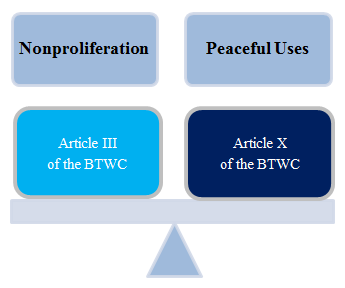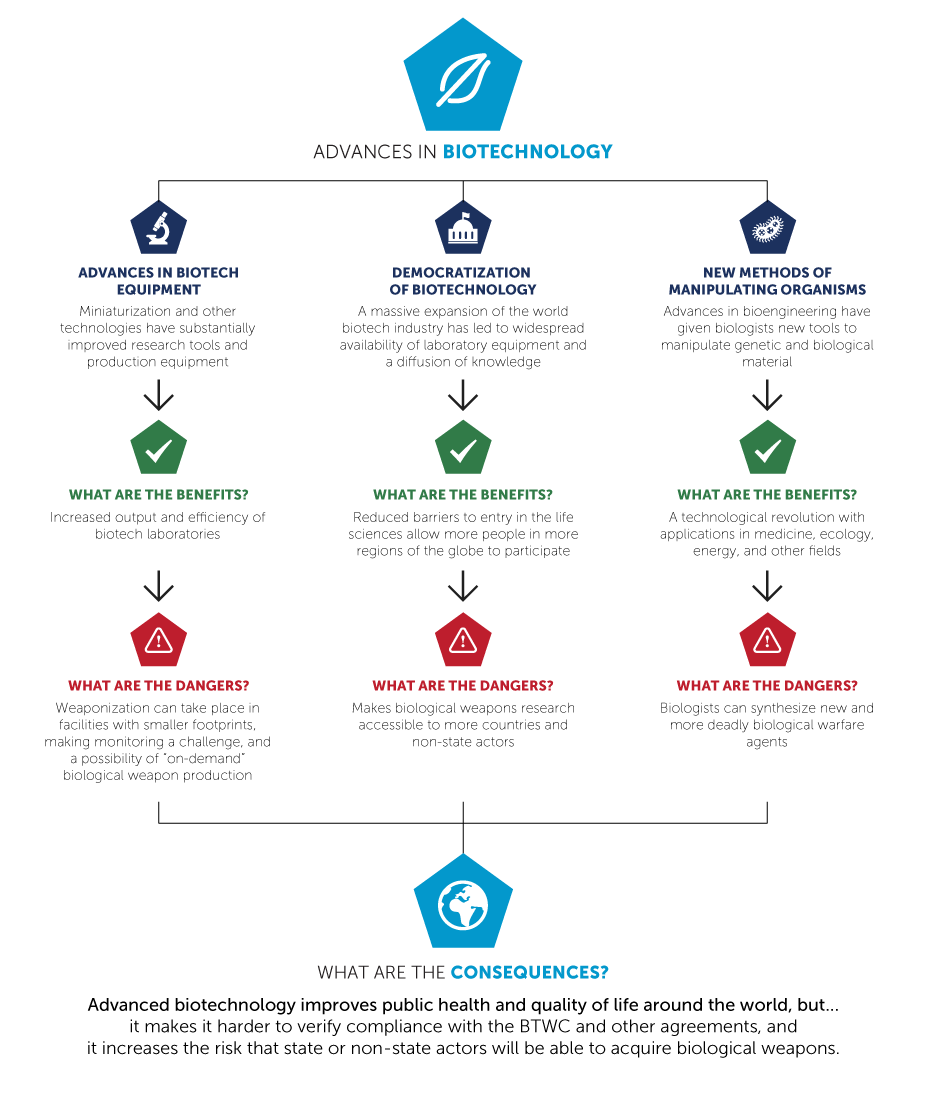1. What are the international legal prohibitions on biological and toxin weapons?
Legal prohibitions on biological and toxin weapons derive from two international instruments, the 1925 Geneva Protocol and the 1972 Biological and Toxin Weapons Convention (BTWC).
The 1925 Geneva Protocol
Agreed in June 1925 and entering into force in February 1928, the Geneva Protocol for the Prohibition of the Use in War of Asphyxiating, Poisonous or Other Gases, and of Bacteriological Methods of Warfare was the first international effort to control biological weapons. It prohibits only the use of biological and toxin weapons in war.
As of 2016, 140 countries have ratified or acceded to the Geneva Protocol. Many states have done so with reservations stating that they have the right to retaliate in kind if another state uses such weapons against them. Thus, the Geneva Protocol is effectively a no-first use policy.
Most legal scholars now consider the Geneva Protocols to be customary international law, and as such binding on all states regardless of whether they have ratified the treaty. [1]
The 1972 Biological and Toxin Weapons Convention (BTWC)
Agreed in April 1972 and entering into force in March 1975, the BTWC is a treaty banning the development and stockpiling of biological weapons. It was the first multilateral disarmament treaty banning the development and production of an entire category of weapons.
180 countries have ratified the Convention and an additional 6 have signed it. Only 12 countries have neither signed nor ratified the BTWC. [2] Of these 12, the only non-member state with an advanced biology sector is Israel. [3]
In addition to banning biological weapons, the BTWC obligates its members to assist other State Parties that have been victimized by a violation of the treaty, and to “undertake to facilitate” the exchange of bioscience knowledge for peaceful purposes.
2. What challenges does the BTWC face?
Verification
|
Institutional Issues
|
Lack of Political Attention
|
3. What are the challenges of balancing peaceful uses of biotechnology with nonproliferation?
The BTWC contains provisions both prohibiting the proliferation of biological weapons (Article III) as well as committing member states to “the fullest possible exchange” of peaceful biotechnologies (Article X). States Parties have varying views on how best to balance these two goals.

Some states, particularly members of the Non-Aligned Movement (NAM), see Article III on nonproliferation and Article X on promotion of peaceful use of biotechnology as equally important. They interpret Article X as an obligation for developed countries to share their expert knowledge with less-developed countries. Several states feel that developed countries have not fulfilled this obligation, and have called for the establishment of a formal mechanism for scientific cooperation. A few states also oppose the view that compliance with the BTWC’s Article III necessitates national strategic trade controls, which in their view restrict the free flow of biological technology and knowledge.
Other states view disarmament and nonproliferation as the primary goal of the BTWC. Therefore, the aim of Article X is principally to ensure that the nonproliferation goals of the treaty do not hinder peaceful activities. These states are generally supportive of strategic trade controls and view them as necessary for compliance with Article III.
4. Why is biodefense research often controversial?
Biodefense research is allowed under the BTWC. This activity, conducted by governments and the private sector, focuses on developing systems to detect, characterize, and respond to biological attacks. However, large-scale defense programs are often controversial.
- Risk of accidents and security incidents: Large-scale biodefense programs place more people in the position of handling agents with potential military applications at a larger number of sites, and therefore increase the risk of accidents and security incidents.
- In 2015, the U.S. Army accidentally shipped live B. anthracis (anthrax) spores to laboratories around the U.S. and seven foreign countries. Although no one was infected as a result, a Department of Defense official described the accident as a “massive institutional failure.” [6]
- Bruce Ivins, a research scientist at the Department of Defense who was ultimately named by the Federal Bureau of Investigation (FBI) as the sole perpetrator of the 2001 “Amerithrax attacks,” allegedly obtained the virulent spores and the knowledge to weaponize them through his position within the U.S. biodefense research program. [7]
- The U.S. government’s decision to greatly increase funding for biodefense after the Anthrax attacks led to rapid growth in the number of biodefense laboratories. Some argue that federal oversight has not kept pace. [8]
- Challenge of identifying biological threats: Biodefense programs prioritize their research and focus on the most likely threats. Some question the value of these investments, arguing that defensive measures will always lag behind offensive capabilities. Others contend that basing threat assessments on what is theoretically possible will lead to worst-case speculation and wasteful spending. [9]
- Security risks of publishing: Research into pathogens is often most effective if published and shared within the scientific community. Such information sharing allows other scientists to confirm the original results and to build on those insights in their own work developing cures and vaccines. However, publishing in open-source literature could, in theory, reveal information that could be used by states or non-state actors for biological warfare purposes.
- Risk of international misperception: As discussed in Module 1, activities for offensive and defensive research often use the same equipment, technologies, and techniques, so that it can be difficult to tell offensive and defensive programs apart. Biodefense programs might be perceived as offensive biological weapons research programs, potentially leading to international tensions, spiraling biodefense programs, or even spurring a biological arms race. [10]
5. How are new technologies transforming the biological threat?
Advances in the life sciences could have significant implications for the types of threats we face in the future and our options for dealing with them. Possible implications are depicted in the below diagram.

Sources
[1] Nicholas A. Sims, The Evolution of Biological Disarmament, SIPRI Chemical & Biological Warfare Series volume 19 (New York: Oxford University Press, 2001), p. 152.
[2] The United Nations Office at Geneva, “Disarmament- Membership of the Biological Weapons Convention,” accessed February 5, 2014, http://www.unog.ch/__80256ee600585943.nsf/(httpPages)/7be6cbbea0477b52c12571860035fd5c?OpenDocument&ExpandSection=1%2C3#_Section1.
[3] Michael Kort, Weapons of Mass Destruction (New York: Facts on File, 2010), pp. 86-87, 89-90.
[4] Comprehensive Report of the Special Advisor to the DCI on Iraq’s WMD Volume 3 – Biological Warfare (Washington, DC: GPO, September 2004).
[5] David P. Fidler, “Outcome of the Sixth Review Conference of the Biological Weapons Convention, November-December 2006,” Insights 11, no. 3 (February 23, 2007), http://www.asil.org/insights/volume/11/issue/3/outcome-sixth-review-conference-biological-weapons-convention-november.
[6] Cronk, Terri Moon, “Work Vows DoD’s Live Anthrax Incident ‘Will Never Happen Again.'” DoD News, Defense Media Activity, July 23, 2015. Accessed December 9, 2016, http://www.defense.gov/News/Article/Article/612686.
[7] David Malet and Herman Rogers, “Biological Weapons and Security Dilemmas,” The Whitehead Journal of Diplomacy and International Relations XI, no. 2 (2010): 105-115, http://blogs.shu.edu/diplomacy/files/2012/05/008_Malet_Layout-1a.pdf.
[8] David Malet and Herman Rogers, “Biological Weapons and Security Dilemmas,” The Whitehead Journal of Diplomacy and International Relations XI, no. 2 (2010): 105-115, http://blogs.shu.edu/diplomacy/files/2012/05/008_Malet_Layout-1a.pdf.
[9] Victor W. Sidel, “Defense Against Biological Weapons,” in Biological Warfare and Disarmament: New Problems/New Perspectives, ed. Susan Wright. Lanham, MD: Rowman and Littlefield, 2002; Jonathan B. Tucker, “Avoiding the Biological Security Dilemma,” Biosecurity and Bioterrorism 4, no. 2 (2006): 195-199, http://online.liebertpub.com/doi/pdf/10.1089/bsp.2006.4.195.
[10] Victor W. Sidel, “Defense Against Biological Weapons,” in Biological Warfare and Disarmament: New Problems/New Perspectives, ed. Susan Wright. Lanham, MD: Rowman and Littlefield, 2002.
Photo Credit
Header Image: Medics prepare to fight Ebola in Sierra Leone, Source: UK Department for International Development (DFID) via Flickr


